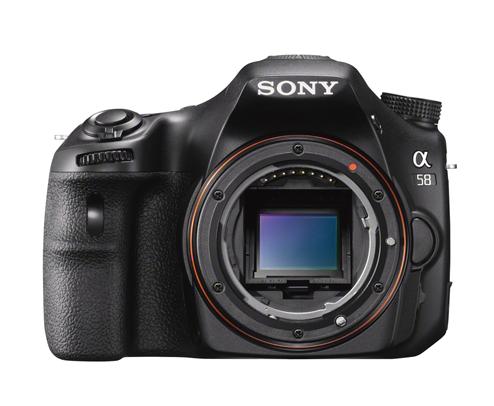Review – Canon Speedlite 600EX-RT
By: Justin VanLeeuwen | Twitter
Discuss the Canon Speedlite 600EX-RT
Preface:
Let’s be honest, Canon hasn’t always been known for their innovative
flash technology. Sure, the speedlights worked, and there was a system
of sorts to remotely trigger them, but they truly paled in comparison to
Nikon’s “CLS” offerings. As a Canon shooter, you could put up with a
spotty infra-red control system that required line-of-sight and barely
worked outdoors, or invest heavily in third-party radio triggers like
Pocket Wizards. When I was shooting 580EXII’s, just a year ago, I knew
that each flash purchase meant a Pocket Wizard purchase too, adding a
few hundred dollars to the purchase price just to make it work reliably
for my needs. Even then, nothing was guaranteed; once you’re dealing
with the flash, a PC sync cable and the remote, you have multiple levels
of failure. “Why didn’t that flash pop? Is it the speedlight’s
batteries? Is the cable attached? Is the cable working? Is the trigger
working? Are the trigger batteries dead?” So many variables can really
be a downer on a shoot, especially if you’re working fast. To boot, once
you put the speedlight into a light modifier like a Westcott Apollo
softbox, you’d lose line-of-sight (which the infra-red system relied
on), thus losing any level of remote control over the light output.
You’d have to go back to the flash every time, manually adjust it, and
try again.
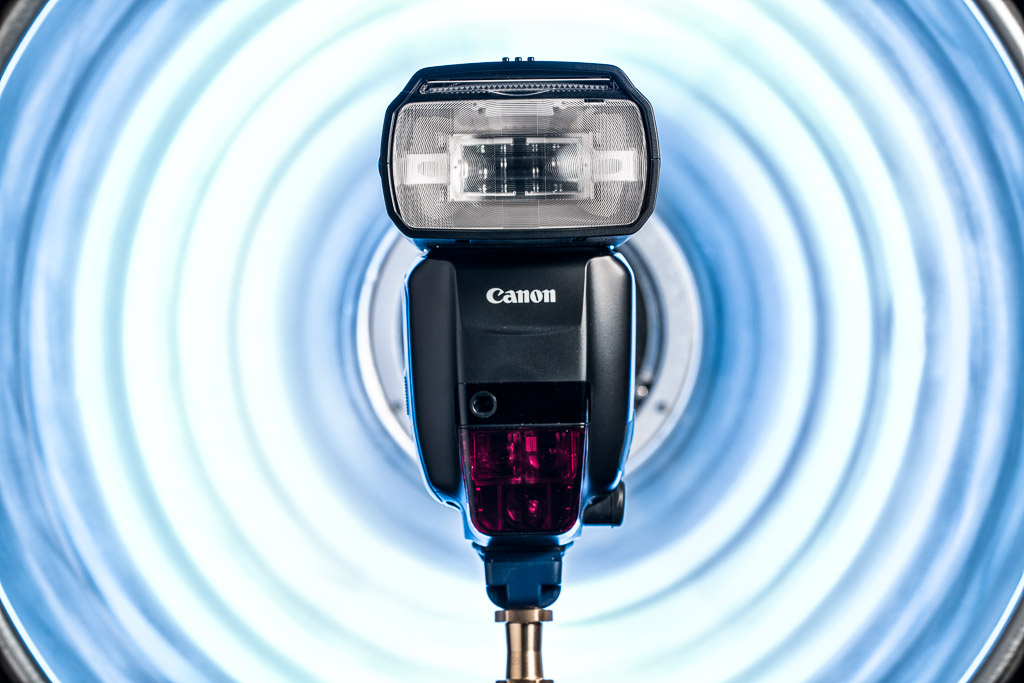
600EX-RT with a sto-fen diffuser behind the product, 1 600EX-RT with 2 CTS gel’s, through a Lumiquest Softbox 3 at camera right.
Pocket Wizard released what I had hoped to be a saving grace to this:
the MiniTT1 & FlexTT5 remote system, promising wireless TTL control
of the flashes (TTL, for those who don’t know, is “Through The Lens”
flash metering, where the camera automatically adjusts the speedlight’s
level for an ideal output). But it wasn’t to be. The radio-frequency
interference from the 580exII severely crippled the range of the PW’s (I
was pissed, weren’t these designed SPECIFICALLY for these flashes?
Who’s beta testing this stuff?). So now I’ve got a few thousand dollars
of flashes and triggers, and none of them really do what they’re
supposed to do, or more accurately, what I need them to do. Frustrating
is an understatement, and I end up buying Lumopro’s excellent LP160s.
“dummy” flashes with manual-only settings for less than half the price
of a 580exII. They at least offered optical triggering, which means
they’ll “pop” when another flash does – “something Canon has never seen
much value in, it would seem.

2x 600EX-RT’s through a 64” Photek Softlighter II
Everything was a compromise, a trade-off, and often a futile effort.
Canon released the 7D which offered speedlight control with its pop-up
flash; that was cool, it worked indoors well enough. But I don’t always
get to choose where I work, and my long term goal was to shoot full
frame, so there’s another compromise; no pop up flashes on the 5D
series. Would I have been better off just switching to Nikon? Their CLS
system offered optical triggers and control from the base that was
consistent and worked.
Enter the Canon 600EX-RT
I’m not going to say radio transmission technology is revolutionary,
it’s been around for a hundred years, but integrating it into a flash
system has been a revelation for my work.
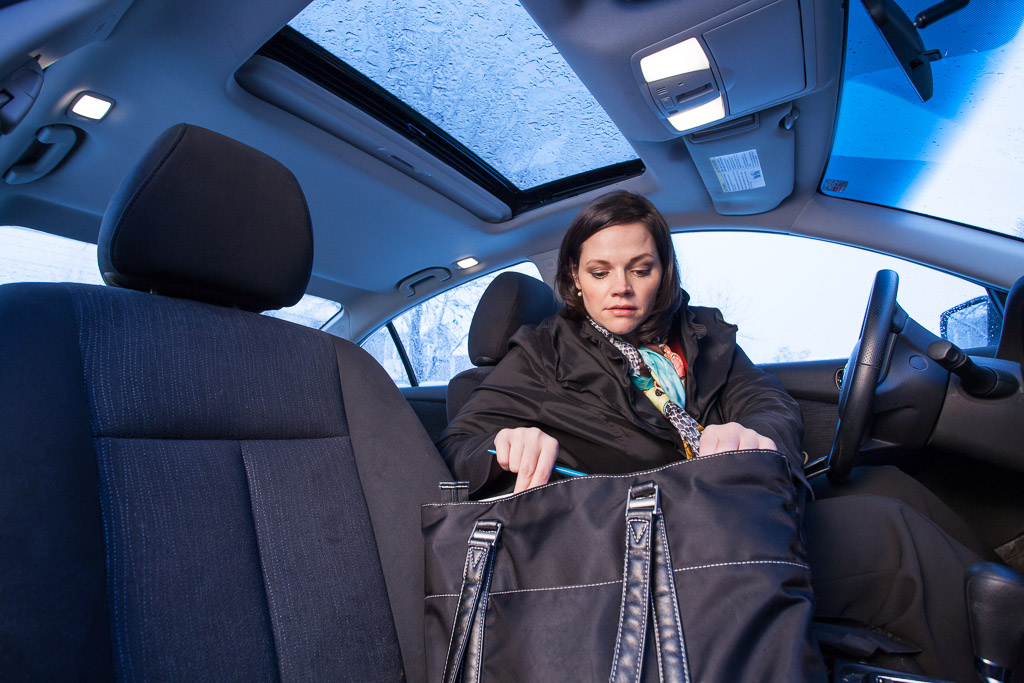
1
CTO’d Canon 600EX-RT through a photek softlighter on-axis and behind
the camera, 1 CTO’d Canon 600EX-RT through a gridded 28” Westcott Apollo
Softbox behind the subject to camera right.
Selling off my 580exIIs wasn’t easy. Their drop in price meant I was
selling two flashes to one 600ex-RT purchase. But this is about work and
the ability to dynamically change your flash settings without leaving
the camera. It meant I could have a flash inside a softbox and it would
trigger without wiggling a cable, I could change the setting from TTL to
manual from the commander unit. Sold. Done. Let’s do this.
For this new “RT” system to work for you, you’ll currently need
either two 600EX-RTs (one to act as a Master/Commander unit) or the
ST-E3-RT transmitter. I rarely, if ever, shoot with a flash in the
hotshoe of my camera, so I picked up the ST-E3-RT which has all the same
control functions as having a 600EX-RT, except, obviously, it’s not a
speedlight.
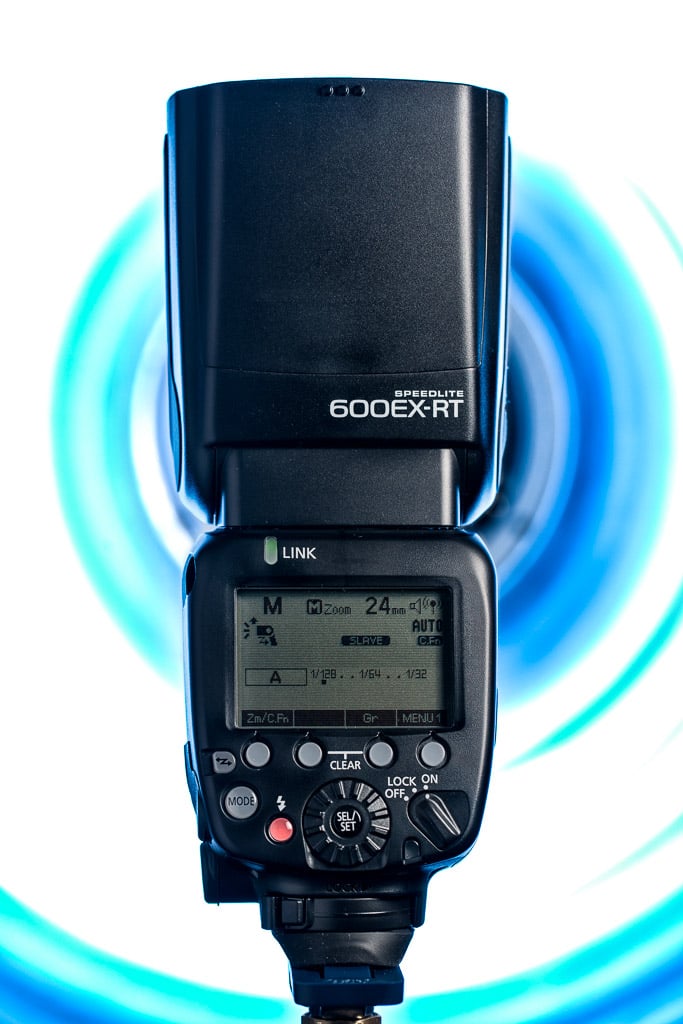
600EX-RT Rear Menu
A flash’s menu system can be quite daunting, and to the unfamiliar,
many of the symbols and functions are a mystery. More than almost any
other piece of gear, I highly suggest you R.T.F.M and play around
extensively with the various features of any speedlight you buy. For
quick reference, I keep a PDF copy of the instructions on my phone at
all times.
Build
I’ve always found Canon’s flashes to be more aesthetically pleasing than
Nikons; a bit more rounded at the edges and all-around a better design.
The Canon 600EX-RT is larger and heavier than the 580EXII, Canon’s
previous flagship flash, which I will never suffer again. A metal foot
is necessary to hold the weight (add 4AA batteries to make it go,
obviously), and it includes a slide-lock clamp to hold the foot in place
on your hotshoe or cold-shoe of choice. The clamp has rubber around it,
as does the battery compartment door, so this flash is considered
weather-sealed for all your rainy-day flash needs. There is a rubberized
button to “unlock” and swivel the flash head at the top that I find
rigged and firm, but not stubborn, to move and lock the flash head in
the desired position. Rubberized plug covers also adorn the side where
you’ll find the PC sync cord port (in case you still wanted to use your
Pocket Wizard or other trigger system), the external power supply port
and the little metal screw port that I’ve never seen anyone use…
There are a few new buttons which I’ll get into in a bit, including
the wireless button and a new “lock” feature in-between off and on; this
locks the speedlight functions so you don’t inadvertently change them
when handling the flash.
Like other canon flashes, it has a pull out catch-light panel to help
those shooting on-camera flash with a little fill if aimed straight up,
it also has a pull out wide-angle diffuser to help expand the flash
range to 14mm.

2x Canon 600EX-RT’s through a 64” Photek Softlighter II
The Canon 600EX-RT comes with a few new accessories. Included is the
standard Canon flash “foot” to help it stand on shelves and such.
There’s also a secondary pouch (with a tiny clip so you can fasten it to
the flash pouch) that contains a clear plastic cap that acts as a
filter holder for two included specially shaped colour gels. I find this
to be an awkward solution; if you’ve seen how Nikon stores all these
same parts for its SB910 you’ll wish Canon had integrated it better.
Functions & Features
Like all my reviews, I don’t intend on technically measuring flash
pulses or light output, recycle times using different batteries and
comparing the results; this review is from a real-world use of the
product.
The Canon 600EX-RT does expand the telephoto range of the flash to
200mm – up from 105mm in the 580exII -“giving you better coverage when
shooting with a telephoto lens, or a more controlled beam of light if
you’re using the zoom function creatively. The 600EX-RT also retains the
infra-red based TTL technology making it compatible with other Canon
flashes that share a master/slave function. The 600EX-RT can, in itself,
act as a master or slave (secondary) flash in a multiple light setup. A
new button has been added, a little “Z” shaped arrow that turns on the
single most significant reason to purchase this speedlight: the Wireless
Button.
After turning your flash on, it’s a simple matter of pressing the
wireless button once to set the flash to Master (in order to control
other Canon 600EX-RTs around), a second press sets it to slave, so it
can be controlled by a Master 600EX-RT or a ST-E3-RT. A third and fourth
push of the button put you in the old-fashioned IR control mode which
still sucks but if you have older speedlights, then you can at least
still use them this way.
The 600EX-RT supports E-TTL, Manual control in 1/3rd stop intervals
as low as 1/128th power, “Multi” which allows you to fire multiple
flashes at requested intervals within a pre-set amount of time, “EXT. A”
and “EXT. M” which give the flash control of the metering (instead of
“Through The Lens” it’s basically through the flash).
The included filter holder and full CTO (colour temperature orange)
gels let you match your flash’s colour output to tungsten light sources.
These are specially cut to fit the whole flash head, and they wrap
slightly under it to a sensor which automatically detects the colour and
sets that to white in camera, if you’re using the auto white balance
(you can choose to turn this off too). While this is a handy feature, at
the time of writing this review, you cannot purchase additional gels
other than the two. Currently, I buy large sheets of colour gels (about
$5 for a 24″x24″ sheet) and cut them myself, I can pick almost any
colour imaginable. $19.95 for official replacements just for the
“special shape” of these gels is way overpriced, not to mention sorely
inadequate in selection. I actually wish Canon made a special die-cut or
scissor I could buy to cut out my own gels, and build on the two colour
corrections with other common gels like green and blue. Nonetheless,
it’s a nice additional feature to help balance the colour of light under
certain situations.

Canon 600EX-RT with a sto-fen diffuser attached through a 28” Westcott Apollo Softbox
Use
Setting up a 600EX-RT is incredibly simple. I opted to turn on the
optional “beep” function so I know when the flash is recycled and ready;
the sound also translates over to the ST-E3-RT transmitter to let me
know the flashes are connected wirelessly. Flip the switch to “On”,
press the wireless button twice to enter slave mode, and set your group,
A-D.
There is a restriction on the number of flash units you can control
within these five groups using the radio transmitter, though I haven’t
met many photographers with up to, let alone more than, 15 speedlights
(that’s about $7,500 in lights).
Another restriction is on cameras released before 2012. If you don’t
own a 5DMK3, a 6D, or a 1DX, you are limited by the number of groups you
can control and how you can control them. One of the most versatile
control functions of the 600EX-RT is that you can independently manage
the five different groups, setting them to shoot manually, E-TTL, or
EXT-A, in a mix-and match setup to suit your needs. With the older
cameras, you’re limited to three groups and ratio control only. This was
pretty disappointing when I first set it up on my 5DMKII, and I was
quick to upgrade to a 5DMKIII to take full advantage of the expanded
feature set.
Once your flash groups are set up you can position the flashes in
your light modifier (or modifiers) of preference. Let me use a basic
three light setup as an example:

2x
Canon 600EX-RT’s through gridded Westcott Apollo Strip Lights (no
diffuser) on the left and right of the subect at the rear, 1 CTO’d Canon
600EX-RT at camera right through a 28” Westcott Apollo Softbox
I’ve set up 3 600EX-RTs all controlled by a ST-E3-RT transmitter. The
600EX-RT in the forward 28″ Apollo softbox is set to Group A, and the
two rear lights in Westcott Apollo strips with grids are set to Group B
(I could have set one to C but I want these to be equal in power at all
times). All of these lights are contained within the soft boxes and it
would have been difficult, if not impossible, to trigger them without
radio.
My first step is to get my two rear lights properly positioned and
then set to the flash power setting I want. Since I want these to be
consistent, and the camera may have a hard time reading the scene with
rim lights, I’ve set Group B to Manual on my ST-E3-RT. I can turn the
various groups on and off via the transmitter, so leaving group A off I
can experiment with different manual power levels until I find one that
suits the look I’m going for. With those set up, I can then turn my A
channel back on and it will automatically fill in via E-TTL. I can
adjust this on the transmitter or the camera body, by adjusting the
exposure bias to the left or right to taste. Depending on my position
relative to the subject, the Group A flash will vary and this is okay, I
might prefer one look over another. Of course, if I wanted, I could set
group A to manual for a consistent exposure.
Add or take away lights as you like; once they’re set-up you can
adjust their power outputs from where you stand, up to 30m (98.4 feet)
away, well within the range of almost all of my shoots.
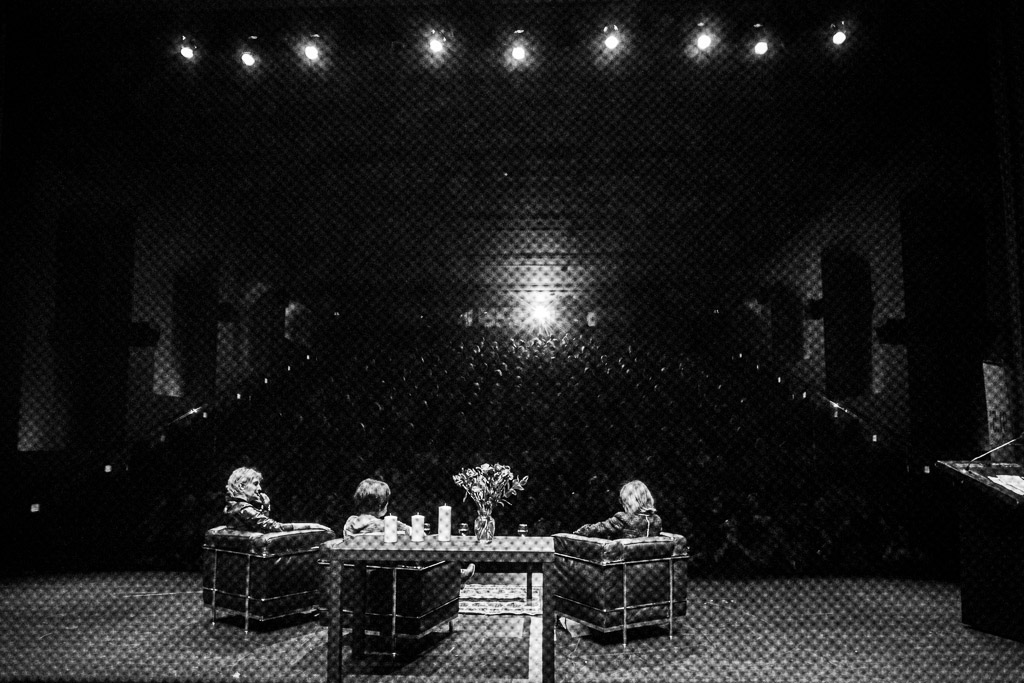
1 Canon 600EX-RT through the projector room in an auditorium
Another practical use of the mixed lighting is with something like
the Orbis ring-flash. Ring flashes are great for use on-camera when you
want to eliminate or reduce shadows on your subject, but moving around
can easily force them to become too bright or too dark based on your
light-to-subject distance. For the next shoot, I had a 600EX-RT in the
Orbis ring-flash set to TTL, and a second 600EX-RT with a red gel
bouncing off a wall just above my subject’s head. While the subject and
wall flash were of consistent distance to each other, the camera (and
me) with the ring-flash attached were constantly changing distances.
Shooting E-TTL helped keep the shoot moving along without any fussing
over the settings. Note: the Orbis is currently the only speedlight
based ring light that will fit the larger head of the 600EX-RT.
Who’s it for?
This flash pretty much does it all, and while it’s clearly aimed at the
pro market, beginners will also benefit from the wireless freedom it
presents. Though many people starting out with a flash rarely take it
off the camera -“ I do hope they will in time.
Event shooters including wedding photographers will find good use of
the Canon 600EX-RT while on the job. Being able to use this same flash
off camera can help while covering the dance-floor and you can
dynamically adjust your settings depending on your position in the room
relative to the light.
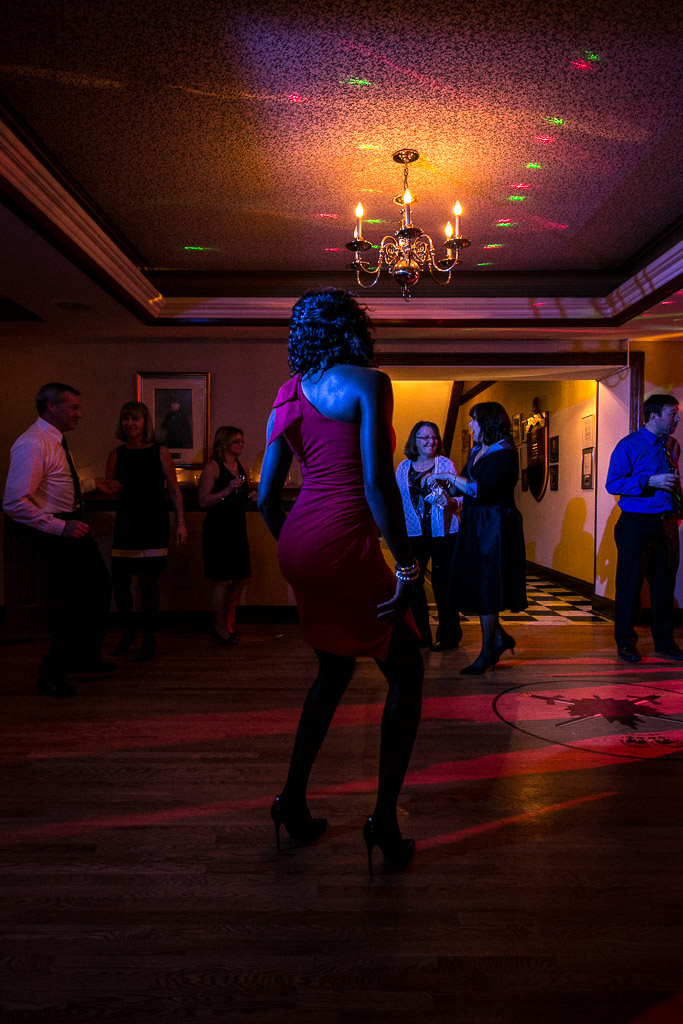
Red gel’d Canon 600EX-RT at camera right, blue gel’d Canon 600EX-RT at camera left.
Editorial photographers and photojournalists will certainly want this
in their kit. The ease and speed to set-up and adjust will pay for
itself just as quickly as those shoots last. In the case of media
scrums, if there are other 600EX-RTs in the room, you can change the
Radio ID through 10,000 different frequencies as well as triggering
units among 15 channels, making it unlikely for your flash to interfere
with someone else’s shot.
Professional portrait and corporate photographers will appreciate the
power to size ratio. While not replacing the pure power output of a
studio strobe, many will augment their lighting setups with a smaller
flash. The sync port at the side allows any number of compatible trigger
systems to take advantage of the flash. You will lose the fine control
you get with the radio, but having the option to still use the light is
valuable. And, in other instances, a few speedlights may be all they
need to quickly and efficiently complete the shoot.
I often use speedlights in my interior photography. A small boost of
light to lessen the dynamic range can greatly enhance the feel of a
location. I can discretely position a number of speedlights and remotely
control all of them manually for the perfect exposure.
Sports shooters will take advantage of the short flash duration for
stopping action, and, while I haven’t experimented with it myself, truly
remarkable things can be accomplished using the “multi” setting and
some motion.
Conclusion
Have a Canon camera? Need more light? Buy this flash. Flash photography
may not be easy to master, but luckily for you, there are so many
incredible resources on the internet to help you learn how to use and
modify your flash to get the look you’re trying to achieve. All I ever
asked for was a flash that actually responded to my needs, making me
feel comfortable and confident on a shoot; just like the 600EX-RT does.

600EX-RT through an Orbis Ring Flash
The only thing the 600EX-RT doesn’t do is set itself up in my flash
modifiers and move itself around on the light stand. Really, I did
mention that shooting with the 600EX-RT was a revelation. Imagine all
the frustration and misfires you had with previous flashes, all the time
spent fine-tuning the manual output settings, or taking apart your
softbox just to access the flash, all that frustration and anger gone,
and in its place? Freedom.
Undoubtedly, Canon will soon update the more affordable 430EXII with
the new “RT” technology, which would open up a lot of entry-level
shooters to the market. That would be my suggestion for someone getting
into camera flash, but knowing the limitations and additional expenses
that come along with expanding your lighting arsenal, I really have to
say the 600EX-RT is the flash to buy for anyone interested in variable
control of their flashes. If you’re on a budget and not concerned about
E-TTL options, I still love my Lumopro LP160′s; they just work. But if
you want versatility and control, ease of use and frustration free flash
lighting, there’s no flash on the market that outshines the 600EX-RT.
Discuss the Canon Speedlite 600EX-RT on the Canon Rumors Forum
Pros
- ETTL “automatic” flash system
- Wireless Radio control
- Backwards compatible with previous Canon flash models
- Easy to navigate button & menu system
Cons
- Most expensive speedlight you can buy
- No other Radio models (currently) available
- No other 1st party flash gels (currently) available




















![Canon EF 12-24 f/2.8L [CR1]](http://www.canonrumors.com/wp-content/themes/magnet/scripts/timthumb.php?src=http://www.canonrumors.com/wp-content/uploads/2012/06/1424patent.jpg&a=t&h=200&w=475)
























